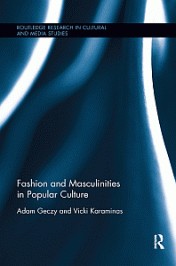With the advent of modernity, the choices of men and women to shape their own character freely, pick their styles and outfit and maybe even follow a new role model were multiplied. Thanks to travel, tourism, modern means of communication, news and image transfer, no longer only the local role models and heroes were attainable for orientation during adolescence.
 While young women still were encouraged to grow into wives and mothers, for young men many fresh role models became available.
While young women still were encouraged to grow into wives and mothers, for young men many fresh role models became available.
As dandies, playboys, or the ways of a sailor, bohemian or cowboy loner also offered new impulses, codes of dress and certain reputations attractive to men in their pubescence, as, moreover, any number of influences would form blends of these models to grow into. Any of these icons, as the authors describe them, offer their own history, fashion styles, mythology and narratives, which were (and still are) transformed and communicated through advertisement, media, and many channels of popular culture.
To show quite a number of possible icons available for young men from roughly the “mid-to-late” twentieth century is what this cooperation between the Senior Lecturer of Sydney College of the Arts, Adam Geczy and Professor of Fashion at the College of Creative Arts, Massey University, Vicki Karaminas is all about.
Not entirely independent of post-feminist and gender studies theories, both authors add a lot of knowledge and experience from cultural studies and the politics of identity formation in Western societies to explain why certain types (and respective fashion styles) attracted more young men than others.
The “crisis of masculinity” of the sixties, referred to rather often in the book, actually happened several times before, for example, at the dawn of the English industrialization and practically always when massive changes in society allowed critical ideas about traditional roles and traits of a “real” man and “real” masculinity. Accordingly, popular culture in contemporary media would pick those up and feature those characters (in their respective mindset, conduct, fashion and outfit).
“Popular culture in the latter half of the twentieth century precipitated a decisive change in style and body image. Postwar film, television, radio shows, pulp fiction and comics placed heroic types firmly within public consciousness. …. As well as demonstrating the role of male icons in contemporary society, this book’s originality also lies in showing the many gender slippages that these icons help to affect or expose.”
By exploring the majority of the numerous male role models of several decades on a short twenty pages each, moreover, the authors uncovered a seemingly overwhelming tendency of almost all these icons to qualify for queerness, considering the makers for such a model or group. “It is also bracing to see how types are inhabited, then twisted and reformed in the interests of resistance …. And the queering of these types also exposes the speciousness of the division between form and content, especially when we see the way that hyper-masculine man can either be straight or gay, or where it is hard to see whether the playboy has become the dandy, or the obverse.”
Therefore, contemporary ideas of masculinity seem or seemed rather unsafe or – if we consider the points taken in the eight chapters here – easily identifiable with other attributes; and these are either not very masculine at all, or even female in character. For example, massive muscular physiques once were a classic indicator for male power and Hellenic physique, but as in the 1970s and 1980s the gay movement became visible and simultaneously bodybuilding no longer was the hobby of just a few, both hetero- and homosexuals were attracted to it.
An absorbing read that will not enlarge on the many icons such as dandies, hipsters, beatniks, sailors, cowboys, superheroes, leather men, Pachucos or the Vampire style, to name only a few mentioned here, but indicates the important (however fluid) tie-in elements that made them attractive, both in terms of fashion and linked mythology, to countless men, for one reason or another. And applying that information could easily expose the origin (in terms of role models) of almost any famous male actor, superhero, or fictional action character in popular culture.
(This review is of the first 2019 paperback edition. The book was originally published in 2018).
Review by Dr. A. Ebert (2020)
Adam Geczy and Vicki Karaminas. Fashion and Masculinities in Popular Culture. (Routledge Research in Cultural and Media Studies) Routledge, 2019, 196p.
